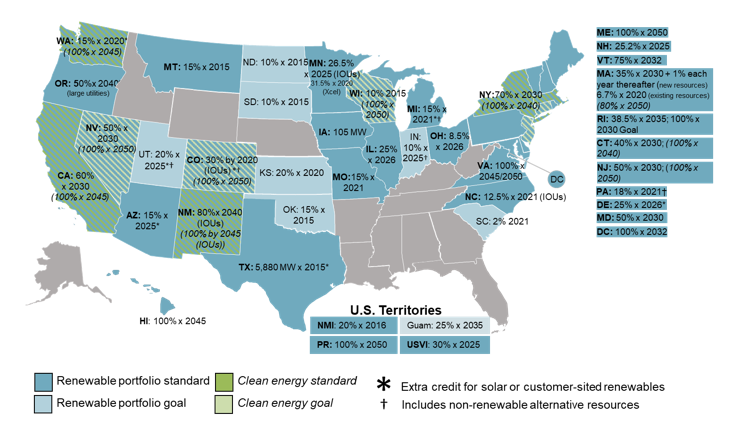By: David Sarkisian, Senior Policy Project Manager
Clean energy standards are policies aimed at increasing the percentage of electricity generated by resources that do not emit carbon dioxide. These standards have substantial overlap with renewable portfolio standards; the difference between the two policy types is that clean energy standards can include some non-renewable, but carbon-free resources, like nuclear energy. The term “clean energy standard” can also refer more generally to the newer generation of renewable and clean energy policies that have aimed to largely (or entirely) eliminate carbon emissions from the power sector, in contrast to earlier renewable portfolio standard policies that had much lower percentage requirements and were aimed specifically at supporting the development of renewable energy technologies. State clean energy policies are also often accompanied by policies aiming to reduce carbon emissions outside of the electricity sector, and may be part of economy-wide greenhouse gas reduction policies.
As we have reached the halfway point of 2021, and most state legislative sessions have ended or are winding down, it is a good time to take stock of what actions states have recently taken on clean energy standards.
Renewable and Clean Energy Standards (July 2021)
Below are states that have taken action on clean energy or renewable portfolio standards since we last reviewed these policies in September 2020:
Arizona
In June 2021, Arizona’s Commerce Commission voted to adopt a goal for net-zero carbon emissions from electric utilities by 2070. This decision came after the Commission rejected a proposal for a similar rule package requiring net-zero emissions by 2050 in May 2021.
The Arizona Commerce Commission has been considering changes to the state’s renewable energy standard and accompanying rule changes since 2018. As the new rules have not yet been formally adopted, they are not yet included on the map above; final adoption is expected to take place in fall 2021.
Massachusetts
In March 2021, Massachusetts Governor Charlie Baker signed Senate Bill 9, adopting a target for net-zero statewide greenhouse gas emissions by 2050. This target had already been adopted on a regulatory basis in 2020 by the state’s Secretary of Energy and Environmental Affairs, but the 2021 legislation formalizes the goal in state law.
The net-zero goal has interim requirements of a 50% reduction by 2030 and a 75% reduction by 2040. Unlike the Arizona policy discussed above, the Massachusetts policy incorporates all sectors of the economy, not just the electric power sector. As Massachusetts has not yet adopted sector-specific requirements based on this new legislation, the targets listed on the map above do not incorporate the requirements of the new legislation.
Michigan
In September 2020, Michigan Governor Gretchen Whitmer issued Executive Directive 2020-10, adopting a state goal to achieve economy-wide carbon neutrality by 2050. This order calls for the State’s Department of Environment, Great Lakes, and Energy to develop an action plan for reducing greenhouse gas emissions and achieving carbon neutrality; the action plan is due to be submitted by the end of 2021, with a draft plan due by September 1, 2021.
Oregon
In July 2021, Oregon Governor Kate Brown signed House Bill 2021, adopting a unique policy quite similar to a clean energy standard. Unlike other policies of this type, which typically specify requirements in terms of percentage of electricity generated, Oregon’s bill specifies greenhouse gas emission reduction targets for its two major investor-owned utilities. The targets require an 80% reduction in greenhouse gas emissions from 2010-2012 levels by 2030, a 90% reduction by 2035, and a 100% reduction by 2040.
Federal Action
In addition to the actions occurring in states, discussions of a possible federal clean energy standard have picked up as part of Congressional infrastructure proposals, with Democrats aiming to include a clean electricity standard as part of their budget reconciliation package. Although specific details on this clean electricity standard are not yet available, Minnesota Senator Tina Smith, one of the lawmakers working to write the legislation, indicated that it would aim for the electricity sector to get 80% of its energy from “clean” sources by 2030. Smith also indicated that the standard would include nuclear energy and fossil fuel energy with carbon capture technology.

